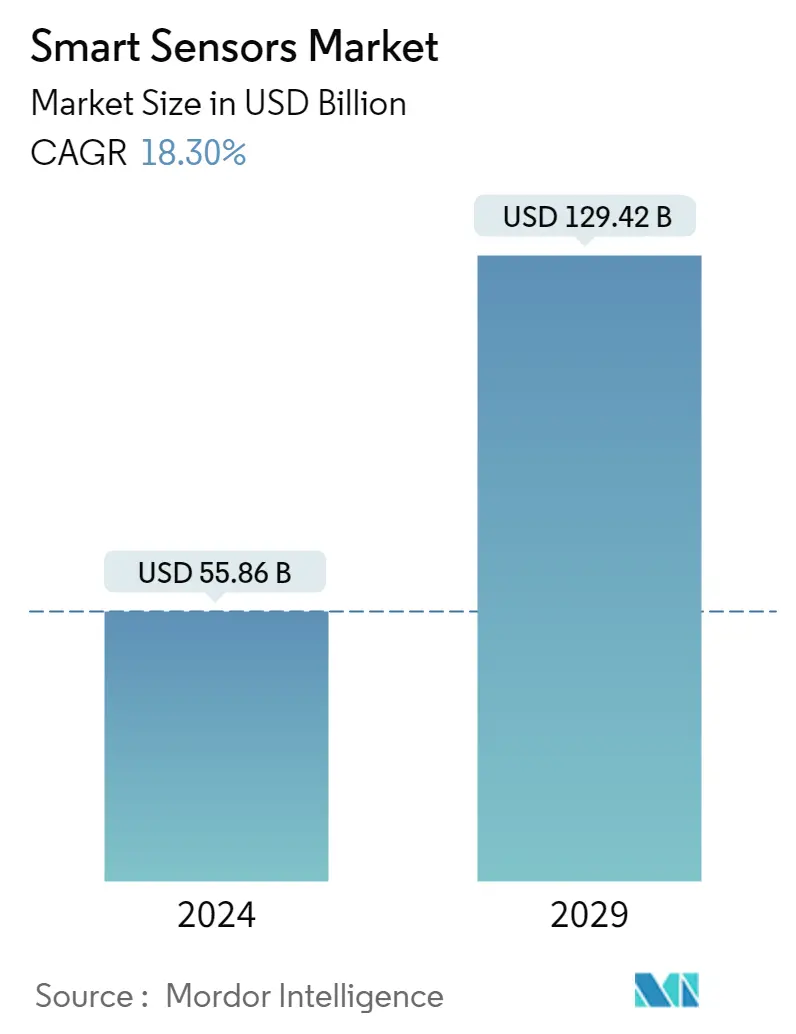
| Study Period | 2019 - 2029 |
| Market Size (2024) | USD 55.86 Billion |
| Market Size (2029) | USD 129.42 Billion |
| CAGR (2024 - 2029) | 18.30 % |
| Fastest Growing Market | Asia Pacific |
| Largest Market | North America |
| Market Concentration | Medium |
Major Players
*Disclaimer: Major Players sorted in no particular order |
Global Smart Sensors Market Analysis
The Smart Sensors Market size is estimated at USD 55.86 billion in 2024, and is expected to reach USD 129.42 billion by 2029, growing at a CAGR of 18.30% during the forecast period (2024-2029).
Sensors have become one of the most crucial and widely used components in various applications. The increasing demand for performance and efficiency has helped in the rising adoption of smart sensors over the past few years.
- Smart sensors can be used to record fluctuations in temperature or pressure acceleration, which are crucial for a process, and in advanced IT solutions like machine-to-machine communication and analytics. These technologies are also used in the automotive, defense, sports, and electronic industries, as well as smart grids, smart cities, and smart environments (forest fire suppression, snow level monitoring, and earthquake early detection).
- These sensors are a huge improvement over traditional sensors since they allow for the automatic collection of environmental data with a much-reduced error rate. Over the forecast period, the market for smart sensors is anticipated to rise due to rising IoT use and penetration, more vehicle automation, and smart wearable health monitoring devices.
- IIoT connectivity innovation is also being driven by long-range, low-power wide-area network (LPWAN) technologies, including NB-IoT, LTE-M, LoRa, and Sigfox. Low-power devices may transmit data packets wirelessly over a larger region with LPWANs for IoT sensors, which is necessary for a manufacturing facility.
- Additionally, governments all over the world are promoting market expansion through advantageous rules and incentives for international enterprises to invest, which is anticipated to accelerate market expansion.
- Additionally, following COVID-19, the market is anticipated to experience a recovery in its growth rate in the years to come as a result of companies increasing their focus on meeting the surge in demand for smart technologies brought on by the rapid acceleration of IoT-based infrastructures, such as smart cities and smart grids, around the world. Additionally, the pandemic has prompted more businesses to update their infrastructure with cutting-edge IoT technology in order to ensure that production is unaffected in the event that another epidemic strikes in the future.
- The COVID-19 outbreak was accelerating the adoption of Industry 4.0, driving businesses from all sectors into a more advanced state of IoT technology and workflow using sensors that have an impact on production, maintenance with altered service intervals, human resources with new job requirements, and marketing with new and in-depth knowledge of customers' individual use cases.
Global Smart Sensors Industry Segmentation
A smart sensor is a device that takes input from the physical environment and uses built-in compute resources to perform predefined functions upon detection of specific input and then process data before passing it on. A smart sensor is also a crucial and integral element in the Internet of Things (IoT)
The Smart Sensors Market is segmented By Type (Flow, Humidity, Position, Pressure, Temperature), Technology (MEMS, CMOS, Optical Spectroscopy), Component (Analog-to-Digital Converter, Digital-to-Analog Converter, Amplifier), Application (Aerospace and Defense, Automotive, and Transportation, Healthcare, Industrial Automation), and Geography (North America (United States, Canada), Europe (Germany, United Kingdom, France, and Rest of Europe), Asia-Pacific (China, Japan, India, and Rest of Asia-Pacific), Latin America, and Middle East & Africa).
The market sizes and forecasts are provided in terms of value (USD million) for all the above segments.
| Flow Sensor |
| Humidity Sensor |
| Position Sensor |
| Pressure Sensor |
| Temperature Sensor |
| Other Types |
| MEMS |
| CMOS |
| Optical Spectroscopy |
| Other Technologies |
| Analog-to-Digital Converter |
| Digital-to-Analog Converter |
| Amplifier |
| Other components |
| Aerospace and Defense |
| Automotive and Transportation |
| Healthcare |
| Industrial Automation |
| Building Automation |
| Consumer Electronics |
| Other Applications |
| North America | United States |
| Canada | |
| Europe | United Kingdom |
| Germany | |
| France | |
| Rest of Europe | |
| Asia Pacific | China |
| India | |
| Japan | |
| Rest Asia Pacific | |
| Latin America | |
| Middle East and Africa |
Smart Sensors Market Size Summary
The smart sensors market is poised for significant growth, driven by the increasing demand for enhanced performance and efficiency across various applications. These sensors, integral to advanced IT solutions and industries such as automotive, defense, and electronics, offer superior data collection capabilities with reduced error rates compared to traditional sensors. The market's expansion is further fueled by the rising adoption of IoT technologies, vehicle automation, and smart wearable health monitoring devices. Innovations in IIoT connectivity, powered by long-range, low-power wide-area network technologies, are also contributing to market growth. Government initiatives worldwide are promoting market expansion through favorable policies, while the post-COVID-19 recovery is expected to accelerate growth as businesses invest in smart technologies to meet the increasing demand for IoT-based infrastructures.
The Asia-Pacific region is anticipated to be a major growth driver, with countries like China and India leading the charge due to their burgeoning end-user sectors and technological advancements. The region's manufacturing hub status, particularly in semiconductors and automotive industries, supports the increased production and marketing of smart sensors. The competitive landscape of the smart sensors market is characterized by the presence of numerous national and international players, with major companies like Honeywell International, ABB Ltd, and Analog Devices Inc. employing strategies such as product innovation and mergers to maintain their market positions. The market's trajectory is further bolstered by the rising demand for connected devices and smart homes, alongside significant government investments in smart infrastructure and technology.
Smart Sensors Market Size - Table of Contents
1. MARKET DYNAMICS
- 1.1 Market Overview
-
1.2 Market Drivers
- 1.2.1 Growing Demand for Energy Efficiency and Saving
- 1.2.2 Increasing Demand for Consumer Electronics Products
- 1.2.3 Higher Demand for Smart Sensors in the Healthcare and Automotive Industries
- 1.2.4 Technology Advancements in Miniaturization and Wireless Capabilities
-
1.3 Market Restraints
- 1.3.1 Relatively High Deployment Costs
- 1.3.2 Complex Design compared to Traditional Sensors
- 1.4 Value Chain Analysis
-
1.5 Industry Attractiveness - 'Porter's Five Forces Analysis'
- 1.5.1 Threat of New Entrants
- 1.5.2 Bargaining Power of Buyers
- 1.5.3 Bargaining Power of Suppliers
- 1.5.4 Threat of Substitute Products
- 1.5.5 Intensity of Competitive Rivalry
- 1.6 COVID-19 Impact Analysis
2. MARKET SEGMENTATION
-
2.1 Type
- 2.1.1 Flow Sensor
- 2.1.2 Humidity Sensor
- 2.1.3 Position Sensor
- 2.1.4 Pressure Sensor
- 2.1.5 Temperature Sensor
- 2.1.6 Other Types
-
2.2 Technology
- 2.2.1 MEMS
- 2.2.2 CMOS
- 2.2.3 Optical Spectroscopy
- 2.2.4 Other Technologies
-
2.3 Component
- 2.3.1 Analog-to-Digital Converter
- 2.3.2 Digital-to-Analog Converter
- 2.3.3 Amplifier
- 2.3.4 Other components
-
2.4 Application
- 2.4.1 Aerospace and Defense
- 2.4.2 Automotive and Transportation
- 2.4.3 Healthcare
- 2.4.4 Industrial Automation
- 2.4.5 Building Automation
- 2.4.6 Consumer Electronics
- 2.4.7 Other Applications
-
2.5 Geography
- 2.5.1 North America
- 2.5.1.1 United States
- 2.5.1.2 Canada
- 2.5.2 Europe
- 2.5.2.1 United Kingdom
- 2.5.2.2 Germany
- 2.5.2.3 France
- 2.5.2.4 Rest of Europe
- 2.5.3 Asia Pacific
- 2.5.3.1 China
- 2.5.3.2 India
- 2.5.3.3 Japan
- 2.5.3.4 Rest Asia Pacific
- 2.5.4 Latin America
- 2.5.5 Middle East and Africa
Global Smart Sensors Market Research FAQs
How big is the Smart Sensors Market?
The Smart Sensors Market size is expected to reach USD 66.08 billion in 2025 and grow at a CAGR of 18.30% to reach USD 153.11 billion by 2030.
What is the current Smart Sensors Market size?
In 2025, the Smart Sensors Market size is expected to reach USD 66.08 billion.


